In today’s rapidly evolving digital landscape, businesses rely on data to make informed decisions and drive growth.
Marketing analytics, a subset of business analytics, provides the tools and techniques necessary to harness the power of data for marketing purposes.
By understanding and leveraging marketing analytics, businesses can gain valuable insights into customer behavior, campaign performance, and overall marketing effectiveness.
A majority of marketers say that data is only “somewhat” important to their overall marketing strategies.
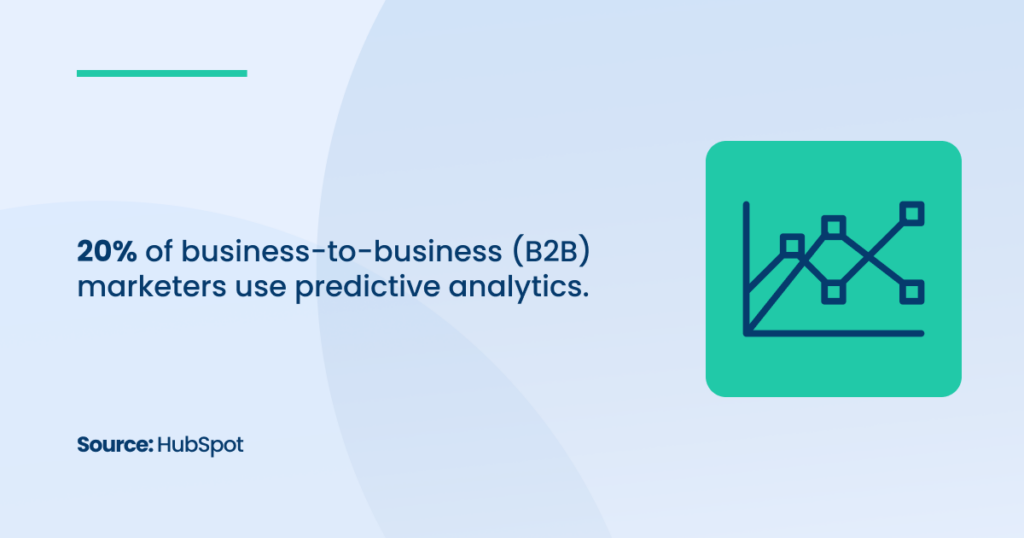
HubSpot highlights that 87% of marketers report that data is their company’s most under-utilized asset.
Emphasizing the need for better tools and strategies, Marketing Analytics & Reporting Agency can transform raw data into actionable insights that drive better decision-making.
The blog post will be a comprehensive introduction to marketing analytics, covering essential concepts, key metrics, and practical applications.
What Is Marketing Analytics?
Marketing analytics is the process of collecting, measuring, and analyzing data from marketing efforts to improve decision-making and drive more effective strategies.
It involves using marketing analytics tools and software to track key metrics, assess campaign performance, and make data-driven adjustments.
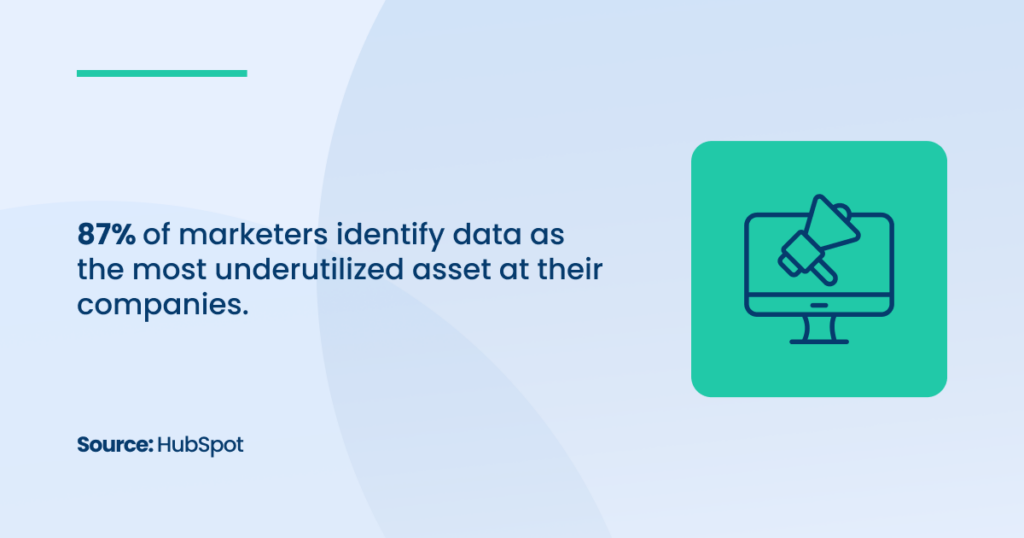
With the rise of digital marketing, the use of digital marketing analytics has become essential for businesses to stay competitive.
By understanding customer behavior, optimizing campaigns, and making informed choices, marketing teams can maximize their return on investment (ROI) and achieve better outcomes.
At its core, marketing analytics helps businesses answer important questions: What works? What doesn’t? Which customers are most profitable? How can marketing efforts be refined to drive better results?
By analyzing data from a variety of sources—such as website visits, social media interactions, email campaigns, and sales figures—businesses can get a clearer picture of their overall performance and understand how to allocate resources more effectively.
The Role of Data in Marketing
Data plays a central role in modern marketing. Businesses now have access to vast amounts of customer data from various touchpoints, such as website visits, social media engagement, and email interactions.
This wealth of data enables companies to tailor their marketing strategy based on concrete insights rather than intuition. By leveraging marketing analytics and reporting, companies can continuously track, analyze, and optimize their marketing campaigns.
The ability to make informed decisions based on data has become critical for staying competitive.
Benefits of Using Data to Inform Marketing Decisions
The use of data analytics and reporting offers numerous benefits for marketers, including:
- Increased Accuracy: One of the primary advantages of marketing analytics is that it allows for more precise targeting and campaign optimization.
By using data analytics techniques, businesses can reduce guesswork and make decisions based on real customer behavior. This leads to better campaign performance and a higher return on investment.
- Better Understanding of Customer Behavior: Marketing analytics tools provide insights into customer preferences, behaviors, and pain points.
By analyzing data from various touchpoints, businesses can create more personalized and relevant marketing messages. This results in higher engagement and improved customer satisfaction.
- Enhanced Campaign Performance: By continuously monitoring and adjusting marketing campaigns based on marketing analytics and reporting, businesses can optimize their strategies in real-time.
This agility allows them to respond quickly to changes in customer behavior or market trends, ensuring that their marketing efforts remain effective.
- Improved Resource Allocation: Data-driven marketing helps businesses identify which channels, campaigns, and strategies generate the best results.
By analyzing performance data, marketers can allocate resources more efficiently, focusing on high-performing areas while reducing spend on underperforming tactics.
- Predictive Insights: One of the most powerful aspects of digital marketing analytics is its ability to provide predictive insights. By analyzing historical data, businesses can forecast future trends and customer behaviors.
This enables them to be proactive in their marketing efforts, preparing for upcoming opportunities and challenges.
- Improved Customer Retention and Loyalty: Marketing analytics can reveal insights about customer satisfaction, engagement, and loyalty.
By tracking key metrics like churn rate and customer lifetime value, businesses can develop strategies to retain customers and increase their overall profitability.
- Better Decision-Making: With comprehensive data analytics and reporting, marketing teams can make more informed decisions.
This leads to better outcomes, as marketers are no longer relying on intuition but are instead basing their strategies on concrete data.
By leveraging the power of marketing analytics, businesses can enhance their marketing efforts, improve customer engagement, and drive long-term success.
Key Metrics to Track
Businesses need to track the right metrics to fully benefit from marketing analytics tools.
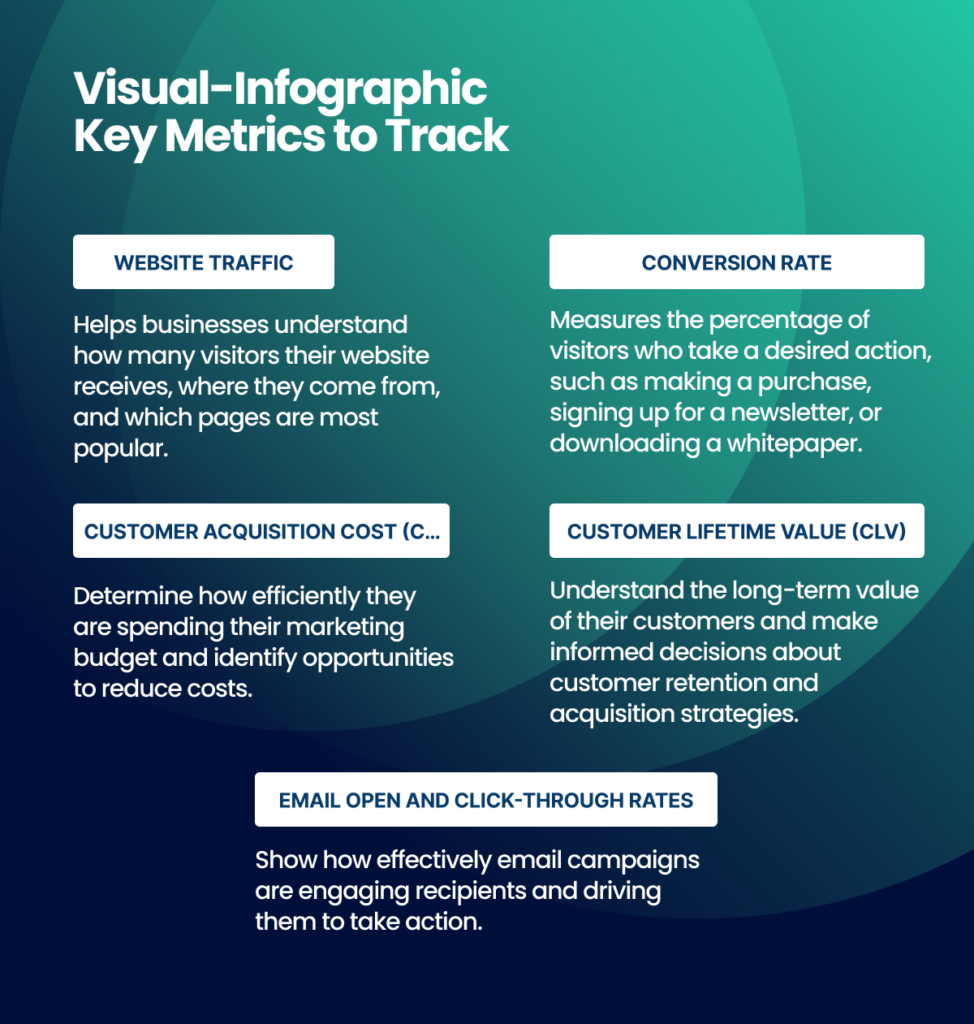
Types of Marketing Analytics
Marketing analytics is essential for making data-driven decisions that enhance marketing strategies, improve campaign effectiveness, and ultimately drive business growth.
There are different types of marketing analytics that focus on various aspects of data and its application. Each type offers unique insights, helping businesses understand past performance, predict future trends, and optimize actions for better outcomes.
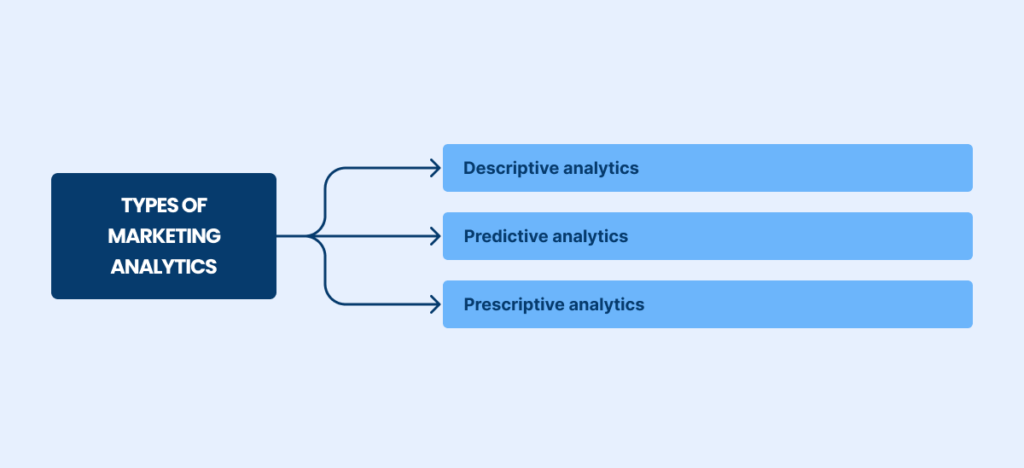
Descriptive Analytics
Descriptive analytics is the most common and foundational form of marketing analytics. It focuses on understanding what happened in the past by examining historical data.

By providing a clear picture of previous marketing activities, descriptive analytics helps businesses evaluate past performance and make sense of raw data. The goal is to use this analysis to identify patterns, trends, and relationships that can inform future marketing decisions.
What Happened?
In marketing, descriptive analytics answers the basic question, “What happened?” It looks at key metrics from past marketing campaigns and provides insights into how those campaigns performed.
For example, businesses can analyze metrics such as website traffic, social media engagement, email open rates, and conversion rates. By understanding these data points, marketing teams can determine whether their efforts met goals, identify what strategies were most effective, and uncover areas that need improvement.
Descriptive analytics is critical in content marketing analytics, where it helps businesses evaluate how well specific types of content perform.
For instance, by looking at past blog post engagement or video view counts, marketers can see which topics resonate best with their audience. This information serves as a foundation for future content planning.
Predictive Analytics
Predictive analytics takes marketing data one step further by using historical data to forecast future trends. By analyzing past performance and applying machine learning algorithms, businesses can predict what will happen in the future.

This type of analytics is particularly valuable in predictive analytics marketing, where companies aim to anticipate customer behavior and market changes to stay ahead of the competition.
What Will Happen?
Predictive analytics answers the question, “What will happen?” by providing marketers with insights into future outcomes based on past data.
For example, by analyzing past customer behavior, businesses can predict which segments are most likely to convert, which products will see increased demand, and which campaigns will drive the highest ROI.
In email marketing analytics, predictive tools can help marketers identify which types of emails are most likely to be opened by certain customer segments, what time of day is best for sending emails, and how to increase click-through rates.
Predictive models allow marketing teams to create highly targeted campaigns that resonate with their audience, increasing the likelihood of conversion.
Prescriptive Analytics
Prescriptive analytics takes data-driven decision-making to the next level by not only predicting what will happen but also providing recommendations on what actions to take.

By combining the power of historical data analysis with machine learning and artificial intelligence (AI), prescriptive analytics offers actionable insights that help businesses optimize their marketing strategies for maximum impact.
What Should We Do?
Prescriptive analytics goes beyond predictions to recommend specific actions that businesses can take to achieve desired outcomes.
For example, if predictive analytics suggests that a particular marketing campaign is likely to underperform, prescriptive analytics would recommend alternative strategies, such as adjusting the budget, targeting different customer segments, or tweaking the messaging to improve results.
In email marketing analytics, prescriptive tools can suggest optimal times to send emails, the best subject lines to use, and which customer segments to target for better engagement.
In content marketing analytics, prescriptive insights can recommend content topics, formats, and distribution channels based on audience preferences and market trends.
How to Implement Marketing Analytics for Your Business
Implementing marketing analytics for your business is critical to gaining insights into customer behavior, optimizing campaigns, and driving business growth.
With data-driven strategies becoming essential for success, businesses need to adopt an effective approach to gathering, analyzing, and utilizing marketing data.
To get the most out of marketing analytics, it’s important to identify clear objectives and select the right tools tailored to your specific needs.
Identifying Key Objectives
The first step in implementing marketing analytics is to identify your key business objectives. Clear goals help define what data should be collected, what metrics need to be tracked, and how success will be measured.
Whether you’re focused on improving customer acquisition, increasing engagement, or driving conversions, your objectives will guide how you set up your marketing analytics strategy.
1. Align with Overall Business Goals
Before diving into analytics, ensure your marketing objectives align with the larger business goals. For instance, if the primary goal is to increase revenue, your marketing analytics strategy should focus on metrics such as lead generation, customer acquisition cost, and conversion rates.
For a B2B marketing analytics approach, tracking the buyer journey and lead nurturing performance would be key. If your business is focused on brand awareness, then website traffic, social media engagement, and content reach may be more relevant metrics.
2. Define Specific Marketing Goals
After aligning with overall business goals, break down those goals into specific, measurable marketing objectives. Ask yourself: What are the key performance indicators (KPIs) that will help us achieve these objectives?
If you’re focusing on email marketing analytics, your goals might include increasing open rates, improving click-through rates, or boosting conversions from email campaigns.
For content marketing analytics, your objectives might include enhancing engagement, increasing time on site, or improving SEO rankings.
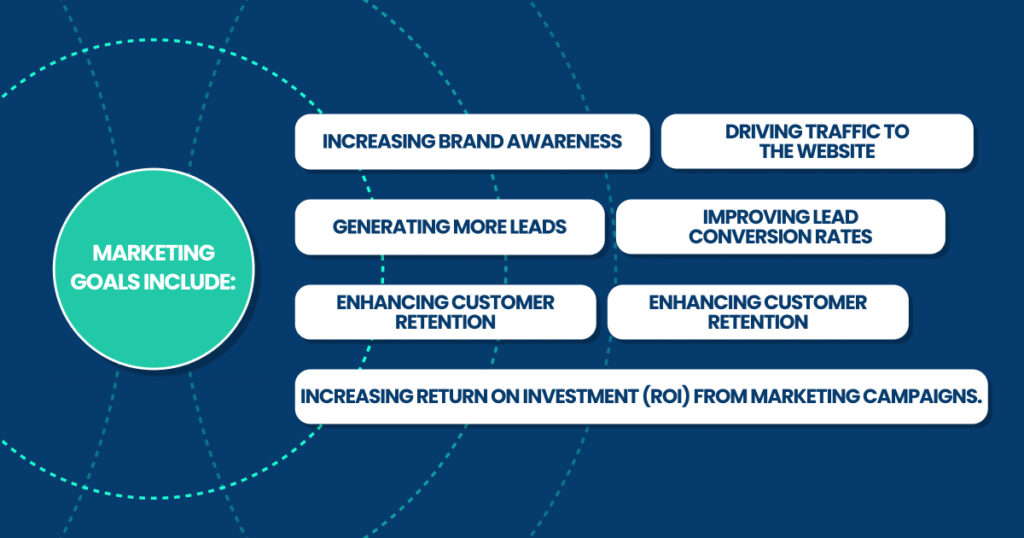
These specific goals help marketers determine what data to focus on and how to measure progress, ultimately ensuring that marketing efforts are aligned with broader business strategies.
3. Identify Target Audiences
To effectively implement marketing analytics, businesses must identify and understand their target audiences. By defining customer segments based on demographics, behaviors, and interests, businesses can track relevant metrics and gain a deeper understanding of customer behavior.
In B2B marketing analytics, it’s especially important to track account-level data, decision-maker behavior, and the effectiveness of targeted campaigns for key clients.
Similarly, content marketing analytics should focus on audience engagement across different content types, ensuring the right messages are resonating with the right people.
Choosing the Right Tools
Once you have defined your objectives, the next step in implementing marketing analytics is choosing the right tools to help you collect and analyze data effectively.
Different types of marketing campaigns require specific tools that are tailored to their unique demands, whether it’s tracking email performance, website traffic, or lead nurturing activities.
1. Email Marketing Analytics Tools
For businesses focused on email campaigns, selecting the right email marketing analytics tool is crucial. These tools provide insights into email performance, such as open rates, click-through rates, bounce rates, and conversion rates.
Popular email marketing platforms like Mailchimp, HubSpot, and Klaviyo offer built-in analytics dashboards that allow marketers to monitor the success of their email campaigns.
Choosing an email marketing tool depends on the scale and complexity of your campaigns.
For example, small businesses may find that Mailchimp’s user-friendly platform meets their needs, while larger enterprises might benefit from HubSpot’s more advanced automation and reporting features. Whichever tool you choose, ensure it integrates well with your CRM and other marketing platforms, as this enables seamless tracking of customer behavior and campaign performance.
2. Content Marketing Analytics Tools
Content marketing plays a crucial role in driving organic traffic, increasing engagement, and building brand awareness. To effectively analyze content performance, businesses need tools that offer comprehensive content marketing analytics capabilities.
Google Analytics is a go-to tool for most businesses. It provides insights into website traffic, user behavior, and content engagement.
In addition to Google Analytics, tools like SEMrush and Ahrefs help businesses track the performance of their content marketing efforts by providing SEO insights, keyword rankings, and backlink analysis.
These tools are essential for businesses looking to improve their content strategy by identifying what resonates with their audience, which topics are trending, and how their content is performing in search engines.
3. B2B Marketing Analytics Tools
When it comes to B2B marketing analytics, businesses need tools that track lead generation, account-based marketing (ABM) performance, and sales funnel progression.
In this space, CRMs like Salesforce or HubSpot CRM provide essential data that help B2B companies monitor lead acquisition, sales conversions, and customer retention.
These platforms integrate seamlessly with other marketing tools, offering comprehensive analytics that enable B2B marketers to optimize their campaigns and refine their targeting.
4. Cross-Channel and Comprehensive Analytics Tools
For businesses that run multi-channel marketing campaigns, it’s essential to have a tool that provides comprehensive marketing analytics and reporting across all channels.
Google Analytics is a widely used tool for tracking website and traffic sources, but for deeper cross-channel analysis, businesses often turn to platforms like Adobe Analytics or Tableau.
These platforms aggregate data from various sources, including social media, email, paid ads, and website traffic, into a unified dashboard. This enables businesses to track customer journeys across different touchpoints and understand how each channel contributes to overall campaign performance.
For example, by using Adobe Analytics, businesses can gain detailed insights into how customers engage with their brand from initial awareness to final purchase, helping refine both short- and long-term marketing strategies.
Partner with [A] Growth Agency for Your Marketing Analytics
Marketing analytics empowers businesses to make strategic choices. As technology continues to advance, its importance will only grow.
[A] Growth Agency will be next to you. We specialize in turning entrepreneurial dreams into reality with effective, tailored growth strategies.
Growth is our driving force – but speed and execution are our keys to success.
Our professional team is dedicated to delivering data-driven insights and innovative solutions that accelerate your business’s progress.
Moreover, looking ahead, we’re excited about the future, continuing to redefine growth for businesses.
Don’t wait for longer.

